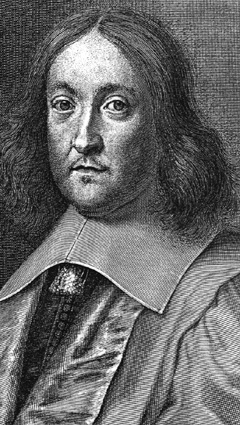 Born:
Born: 17-Aug-1601
Birthplace: Beaumont-de-Lomagne, France
Died: 12-Jan-1665
Location of death: Castres, France
Cause of death: unspecified
Gender: Male
Race or Ethnicity: White
Occupation: Mathematician
Nationality: France
Executive summary: Fermat's Last Theorem
French mathematician, born on the 17th of August 1601, at Beaumont-de-Lomagne near Montauban. While still young, he, along with Blaise Pascal, made some discoveries in regard to the properties of numbers, on which he afterwards built his method of calculating probabilities. He discovered a simpler method of quadrating parabolas than that of Archimedes, and a method of finding the greatest and the smallest ordinates of curved lines analogous to that of the then unknown differential calculus. His great work
De Maximis et Minimis brought him into conflict with René Descartes, but the dispute was chiefly due to a want of explicitness in the statement of Fermat. His brilliant research entitled him to rank as the founder of the modern number theory. They originally took the form of marginal notes in a copy of Bachet's
Diophantus, and were published in 1670 by his son Samuel, who incorporated them in a new edition of this Greek writer. Other theorems were published in his
Opera Varia, and in John Wallis's
Commercium Epistolicum (1658). He died in the belief that he had found a relation which every prime number must satisfy, namely 2^(2n) + I = a prime. This was afterwards disproved by Leonhard Euler for the case when n = 5.
Fermat's Theorem, if p is prime and a is prime to p then a^(p-1)- I is divisible by p, was first given in a letter of 1640.
Fermat's Problem, or more commonly,
Fermat's Last Theorem is that x^n + y^n = z^n is impossible for integral values of x, y and z when n is greater than 2.
Fermat was for some time councillor for the parliament of Toulouse, and in the discharge of the duties of that office he was distinguished both for legal knowledge and for strict integrity of conduct. Though the sciences were the principal objects of his private studies, he was also an accomplished general scholar and an excellent linguist. He died at Toulouse on the 12th of January 1665. He left a son, Samuel de Fermat (1630-1690) who published translations of several Greek authors and wrote certain books on law in addition to editing his father's works.
The
Opera Mathematica of Fermat were published at Toulouse, in two folio volumes, 1670 and 1679. The first contains the "Arithmetic of Diophantus", with notes and additions. The second includes a "Method for the Quadrature of Parabolas", and a treatise "on Maxima and Minima, on Tangents, and on Centers of Gravity" containing the same solutions of a variety of problems as were afterwards incorporated into the more extensive method of fluxions by Isaac Newton and Gottfried Leibniz. In the same volume are treatises on "Geometric Loci, or Spherical Tangencies", and on the "Rectification of Curves", besides a restoration of "Apollonius's Plane Loci", together with the author's correspondence addressed to Descartes, Pascal, Roberval, Huygens and others. The
Oeuvres of Fermat have been re-edited by P. Tannery and C. Henry (Paris, 1891-94).














 Born: 17-Aug-1601
Born: 17-Aug-1601




















